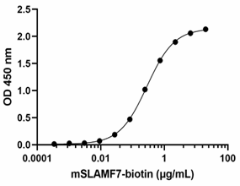- Regulatory Status
- RUO
- Other Names
- CRACC, leukocyte cell-surface antigen 1, CS1, CD319, Protein 19A,CD2 Subset1

-

When recombinant mouse SLAMF7 is immobilized at 5 µg/mL, biotinylated recombinant mouse SLAMF7 binds in a dose-dependent manner with ED50 of 0.25 – 1.5 µg/mL. HRP Avidin (Cat. No. 405103) was used to detect the binding. -

Stability Testing for Recombinant Mouse SLAMF7 (CRACC/CD319). Recombinant mouse SLAMF7 was aliquoted in PBS at 0.2 mg/mL and one aliquot was kept at 4°C (Control), and another was frozen and thawed four times (4x Freeze/Thaw). The samples were tested for their ability to bind to mouse SLAMF7-biotin. The ED50 for this effect is 0.25 – 1.5 µg/mL.
| Cat # | Size | Price | Quantity Check Availability | ||
|---|---|---|---|---|---|
| 565804 | 25 µg | $205.00 | |||
| 565806 | 100 µg | $430.00 | |||
SLAMF7, also knowns as signaling lymphocytic activation molecule family member 7, CRACC, CD319, and leukocyte cell-surface antigen 1 (CS-1), is a cell surface receptor, primarily expressed on immune cells, including NK cell and plasma cells. SLAMF7 is also expressed on dendritic cell, activated monocyte and a subset of T cell. SLAMF7 belongs to SLAM family of receptors, which are involved in regulating immune cell functions and interactions. SLAMF7 possesses an extracellular region comprising of one Ig-like V and one Ig-like C2-set domain, a transmembrane domain and an intracellular domain containing immunoreceptor tyrosine-based switch motif (ITSM). The Ig-like domains mediate interactions with ligands or other receptors, the transmembrane domain anchors the protein in the cell membrane, and the ITSM is responsible for relaying signals to the cell's interior upon ligand binding. The mouse and human SLAMF7 shares 48% amino acid homology. Activation of SLAMF7 occurs by self-ligation of extracellular domain. Upon homophilic receptors activation, downstream signaling modulates NK cell cytolytic activity. SLAMF7 can bind Ewings’s sarcoma-associated transcript 2 (EAT-2) via the ITSM domain leading to the phosphorylation of PLC-γ and PI3K. SLAMF7 expression in myeloma cell is high relative to normal lymphocyte cell subsets which has led multiple investigation of immuno-targeting therapy for multiple myeloma. Upon binding of anti-hSLAMF7 monoclonal antibody, Elotuzumab, to highly-expressed SLAMF7 on myeloma cells, elimination of cancer cells can be by triggered by antibody-dependent cellular cytotoxicity (ADCC) and antibody-dependent cellular phagocytosis.
Product Details
- Source
- Mouse SLAMF7, amino acids Ala22-Gly224 (Accession# Q8BHK6.2), with a C-terminal 10 His tag, was expressed in 293E cells.
- Molecular Mass
- The 213 amino acid recombinant protein has a predicted molecular mass of approximately 23.7 kD. The DTT-reduced and non-reduced protein migrates at approximately 30 – 50 kD by SDS-PAGE. The predicted N-terminal amino acid is Ala.
- Purity
- > 95%, as determined by Coomassie-stained SDS-PAGE.
- Formulation
- 0.22 µm filtered protein solution is in PBS.
- Concentration
- 25 µg size is bottled at 200 µg/mL. 100 µg size and larger sizes are lot-specific and bottled at the concentration indicated on the vial. To obtain lot-specific concentration and expiration, please enter the lot number in our Certificate of Analysis online tool.
- Storage & Handling
- Unopened vial can be stored between 2°C and 8°C for up to 2 weeks, at -20°C for up to six months, or at -70°C or colder until the expiration date. For maximum results, quick spin vial prior to opening. The protein can be aliquoted and stored at -20°C or colder. Stock solutions can also be prepared at 50 - 100 µg/mL in appropriate sterile buffer, carrier protein such as 0.2 - 1% BSA or HSA can be added when preparing the stock solution. Aliquots can be stored between 2°C and 8°C for up to one week and stored at -20°C or colder for up to 3 months. Avoid repeated freeze/thaw cycles.
- Activity
- When recombinant mouse SLAMF-7 is immobilized at 5 µg/mL, biotinylated recombinant mouse SLAMF7 binds in a dose-dependent manner with an ED50 range of 0.25 – 1.5 µg/mL. HRP Avidin (Cat. No. 405103) was used to detect the binding.
- Application
-
Bioassay
- Application Notes
-
BioLegend carrier-free recombinant proteins provided in liquid format are shipped on blue-ice. Our comparison testing data indicates that when handled and stored as recommended, the liquid format has equal or better stability and shelf-life compared to commercially available lyophilized proteins after reconstitution. Our liquid proteins are validated in-house to maintain activity after shipping on blue ice and are backed by our 100% satisfaction guarantee. If you have any concerns, contact us at tech@biolegend.com.
Antigen Details
- Structure
- Monomer
- Distribution
-
NK cells, plasma cells, dendritic cells, activated monocytes, T cells
- Function
- SLAMF7 can regulate immune cell functions and interactions
- Interaction
- Ewings’s sarcoma-associated transcript 2 (EAT-2)
- Ligand/Receptor
- SLAMF7 (Self-interaction)
- Bioactivity
- Biotinlyated recombinant mouse SLAMF7 binds to immobilized recombinant mouse SLAMF7 in a dose-dependent manner.
- Cell Type
- B cells, Dendritic cells, Lymphocytes, NK cells, Tregs
- Biology Area
- Immunology
- Molecular Family
- CD Molecules
- Antigen References
-
- He Yuan, et al. 2019. Nat Commun. 10:533
- Kumaresan PR, et al. 2002. Mol Immunol. 39:1-8.
- Dongre P, et al. 2013. Mol Immunol J. 54:254-63.
- Kim JR, et al. 2016. Immunobiology. 221:31.
- Friend R, et al. 2017. Drug Des Devel Ther. 11:893-900.
- Gutierrez-Guerrero A, et al. 2022. Eur J Immunol. 52:62-74.
- Fouquet G, et al. 2018. Oncotarget. 9:16248-16262.
- Hsi ED, et al. 2008. Clin Cancer Res. 14:2775-84.
- Campbell KS, et al. 2018. Front Immunol. 9:2551.
- Gene ID
- 75345 View all products for this Gene ID
- UniProt
- View information about SLAMF7 on UniProt.org
